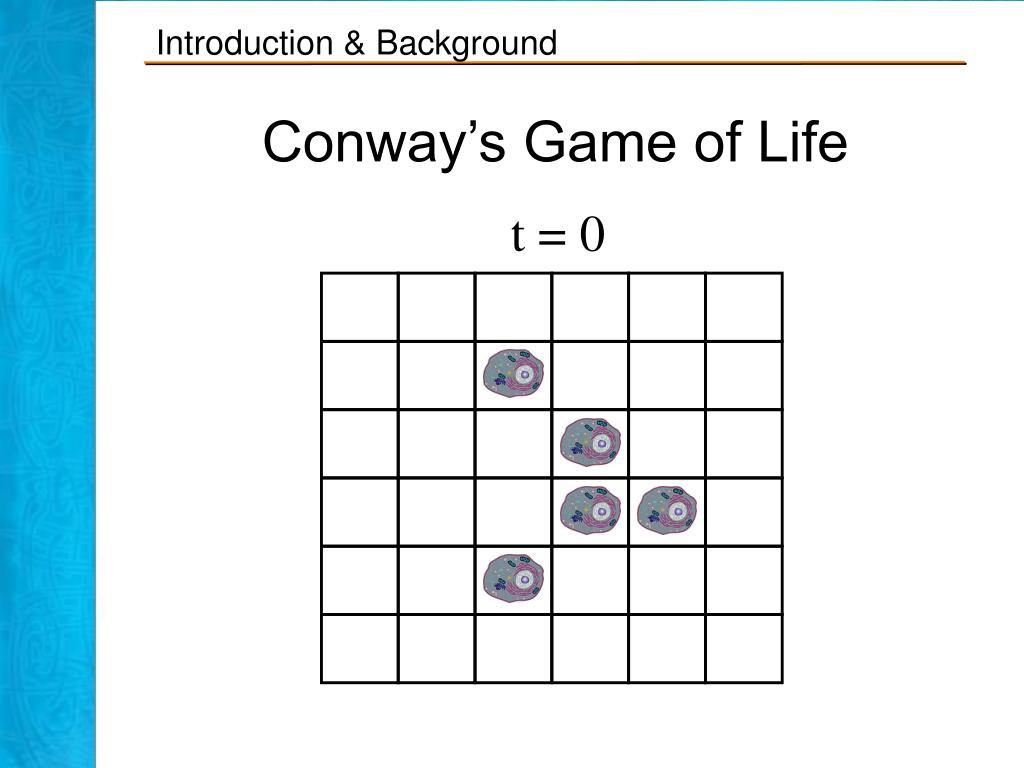

Simulations such as this should humble our understanding of the unimaginable complexities of the living world. The astonishing thing about Conway’s Game of Life is the depth of intricacy that emerges from a simple set of elementary and deterministic laws. Dead cells with exactly three neighbours come to life. The universe of the Game of Life is a 2-dimensional array of cells, each of which takes two. Living cells with greater than three neighbours die. Conways Game of Life is the most well-known cellular automaton. Living cells with either two or three neighbours carry on doing their thing.ģ. Living cells with fewer than two neighbours die. The following four rules define the evolution of the ‘game’:ġ. The destiny of each these tiny imaginary beings is determined by the eight neighbouring cells that surround it. Each cell in the scene holds one of two states – dead (black) or alive (white). Epilepsy warning: This simulation has lots of bright flashing lights.Ī webform that you can use to make grids like Three by Three and Random Rules, or single simulations with different parameters for pixel size and refresh speed.A GPU simulation of Conway’s Game of Life – a basic cellular automation. Every 5-10 seconds each simulation has it's rules and colors updated. This simulation puts 16 simulations on the screen, each with randomly chosen rules. A three by three grid with random colors each playing the standard Conway's Game of Life.ĪKA Channel Surfing. Click on a square to kill all life in that square. Conways Game of Life is a a cellular automaton invented by John Horton Conway in 1970. Two kinds of life (both small modifications of the Creeping Ivy) with different color schemes arranged in a checker board pattern.

Cellular automata can be used to simulate brain. Eventually, one crashes into the "ivy box" which will then fill with life. The cellular automaton is an important tool in science that can be used to model a variety of natural phenomena. With an "Ivy Box" in the middle of the sceen, this simulation randomly spawns a bunch of "gliders". The result reminds me of vines slowly engulfing a building with windows. With a randomized color scheme, this simulation draws 6 boxes of regular Conway's inside of an area with a kind of highly resilient life. Can you identify each of the zones and their rules? The astonishing thing about Conways Game of Life is the depth of intricacy that emerges from a simple set of elementary and deterministic laws. A single horizontal bar of life is drawn somewhere in that harsh environment, the result is a mesmerizing visualization that is a little different every time, and on every sceen size.Īn experiment with many kinds of rules, building on top of the Rainbow simulation. The bottom quarter of this simulation is a little less survivable than the rest, which is regular Conway's. The infinite sequence that started it all, in a satisfying rainbow color scheme. You can also use "rule box mode" to add internal simulations areas of the grid that follow their own rules. Click and drag to add life.Ī grid of Conway's with tools to configure and customize the rules of the game, and the display colors. Choose the rules of life and let the simulation commence This app lets you experience the real power of Conways game of life simulation. In all the pages with a single simulation, pressing z will pause and play the simulation.Ī simple, single instance of Conways game. In all of these simulations clicking, swiping, and clicking/dragging will add life to the simulation. If you want to see more of my projects, visit Teb's Lab.
#Conways game of life simulations code#
Read more about Conway's Game of Life on Medium or Get the code on Github. As time went on, the Game was shown to be Turing Complete, meaning any program could be represented as an initial state to Conway’s Game of Life given a large enough grid. Although each cell follows the same simple rules, wonderful patterns emerge. Invented by John Conway in 1970, the “zero player game” is a wonderful example of emergent behavior.


 0 kommentar(er)
0 kommentar(er)
